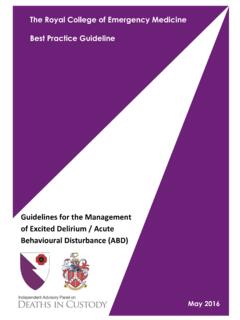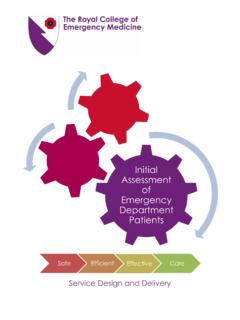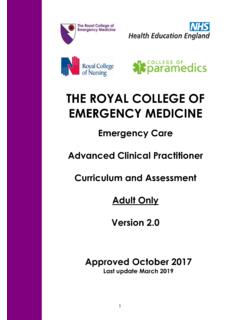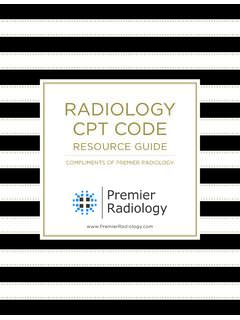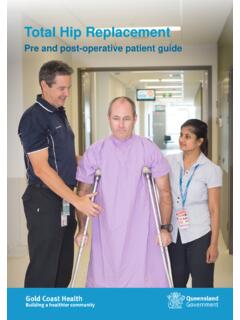Transcription of The Royal College of Emergency Medicine Best Practice ...
1 1 The Royal College of Emergency Medicine Best Practice Guideline Fascia Iliaca block in the Emergency Department Revised: July 2020 2 Contents Summary of recommendations .. 3 Scope .. 4 Reason for development .. 4 Introduction .. 4 Considerations .. 4 Safety of FIB .. 4 Improving safety of FIB .. 5 Controversies regarding FIB .. 5 Efficacy of FIB .. 6 Procedures within ED .. 6 Pain management in fracture neck of femur .. 6 Miscellaneous .. 6 Appendix 1 Example of FIB competency assessment .. 7 Appendix 2 Example of FIB record .. 13 Appendix 3 Example of proforma (text only) .. 15 Appendix 4 Stop before you block /invasive procedure checklist.
2 16 Appendix 5 RCEM safety flash .. 18 Appendix 6 Surface 19 About this document .. 21 Authors/Acknowledgements .. 21 Review .. 21 Disclaimers .. 21 Research Recommendations .. 21 Audit standards .. 21 Key words for search .. 21 3 Summary of recommendations 1. Fascia Iliaca block (FIB or FICB) should be available in Emergency Departments as part of the pain management strategy for patients with fractured neck of femur. 2. Pain management in patients with fractured neck of femur should be instituted as soon as possible (see RCEM standards and guidance on pain management). 3. Administration of FIB should be undertaken only by clinicians who have completed a competency assessment in this skill.
3 A departmental log of competent personnel should be kept up to date. 4. Patients receiving a FIB should be closely monitored during and after (for a minimum of 1 hour) the procedure; for both signs of local anaesthetic toxicity and sedation effects of other analgesia that may have been given. 5. Intralipid should be easily available for treatment of local anaesthetic toxicity in clinical areas where FIB is administered. 6. In departments where FIB is administered, there should be a policy available which includes details of competency assessment, monitoring of patients, and treatment of complications. 7. The use of an invasive procedure checklist, and a Stop before you block process is recommended.
4 4 Scope This guideline is designed primarily for use in Type 1 EDs. Reason for development Fractured neck of femur is a common presentation to the Emergency Department, and is subject to national audit process (1), as well as previous RCEM national audits (2). Delivery of timely and effective analgesia to patients with a fractured neck of femur is challenging, as evidenced by these audits. (2) The use of Fascia Iliaca block in this condition has increased. Whilst there is some evidence to support the use of FIB, this is not conclusive. An RCEM patient safety alert highlighted some of the risks of FIB use. (3) Introduction Fascia Iliaca block (FIB) is being increasingly used in Emergency Departments (ED) including in the United Kingdom, principally for pain relief in fractured neck of femur patients.
5 The advantage of FIB over femoral Nerve block (FNB) is that there is lower risk of intra-neural and intra-vascular injection (see surface anatomy Appendix 5). There is also a theoretical advantage of Lateral Cutaneous Nerve of the thigh blockade (although less utility in the ED setting). Additionally, but again of less relevance in the ED setting, a FNB uses a lower volume of local anaesthetic, and, therefore, allows concurrent use local anaesthetic at another site. Considerations Safety of FIB As with any invasive procedure there are risks. The principal concerns regarding FIB are common to blocks and local anaesthetic use: possibility of trauma to closely associated structures, including femoral canal structures local anaesthetic toxicity risks of infection and bleeding post-procedure failure of technique to provide analgesia 5 Additionally, the RCEM safety alert (3), highlighted the risks of removal of painful stimulus with the instillation of FIB resulting in patients who have had opiates prior to FIB.
6 Improving safety of FIB The above issues are addressed in the FIB guidance in the appendices. Firstly, local anaesthetic toxicity risks are reduced by dose reduction in patient with lower body weight, aspiration every 5mls, close monitoring of patients during and after procedure, and avoidance in those who cannot report early signs of toxicity ( obtunded patients). Ultrasound guidance for the procedure is possible, however, there is currently no evidence that this reduces risks. Identification of injection intraneurally requires an awake patient. Infection risk is low, but this is an aseptic procedure. Bleeding risk is reduced by avoiding in patients on Warfarin/DOAC; there is currently debate about the risk of using this technique in patients who are therapeutically anticoagulated.
7 Wrong site block is a never Event within the UK National Health Service, and risk reduced by using a checklist and Stop before you block procedures. Controversies regarding FIB In appendix 3 there is an example of a simplified proforma for FIB. The original listed contraindications and does not differentiate between absolute and relative. Many departments do separate these; hence this has been modified to provide nuance on two main current controversies that exist: 1. As described above, there is debate surrounding whether patients who are prescribed anticoagulation have an absolute or relative contraindication. There is insufficient evidence to determine this- a local governance decision is required.
8 2. Whether inability to communicate symptoms of intraneural injection, and of local anaesthetic toxicity (especially in patient with cognitive impairment) is an absolute contra-indication. The authors opinion is that given the safety of FIB, and lower risk of these complications compared to other regional anaesthesia (combined to the large clinical spectrum patients in this category) that ability to consent and cooperate with procedure are more significant issues. 6 Efficacy of FIB There is some evidence regarding efficacy of FIB in reducing opiate requirements before and after surgery (4). It is suggested that this has benefits including early mobilisation, and reduction of thrombo-embolism and Lower respiratory Tract Infections.
9 However, despite much anecdotal evidence and opinion, there is little current evidence that this benefit (or avoidance of risk) affects mortality. There is evidence regarding efficacy of FIB in pain relief (5), and regarding safety and use by a wide range of practitioners (6). Procedures within ED Many Quality Improvement Projects (QIPs) submitted for the Fellowship Examination of the Royal College of Emergency Medicine have involved use and introduction of FIB (7). The learning from these QIPs suggests that uptake of FIB within a department can be improved using dedicated pre-prepared block pack , or a block trolley where all required equipment and paperwork is housed.
10 Additionally, electronic proformas, including in patient record assist with auditing. Pain management in fracture neck of femur Management of pain within the ED is a key element of the patient experience. Within patients with a (possible) fractured neck of femur, the delay to effective pain relief can be due to several factors. The use of QIP tools to investigate the causes of delay to pain relief (such as process mapping) and the barriers to efficacy may help an ED understand the local context- however introduction of FIB per se is not usually a magic bullet to solve this issue. However, FIB can be an effective tool in the armoury of clinicians, and can be part of a wider strategy that looks at pain relief in this condition.

